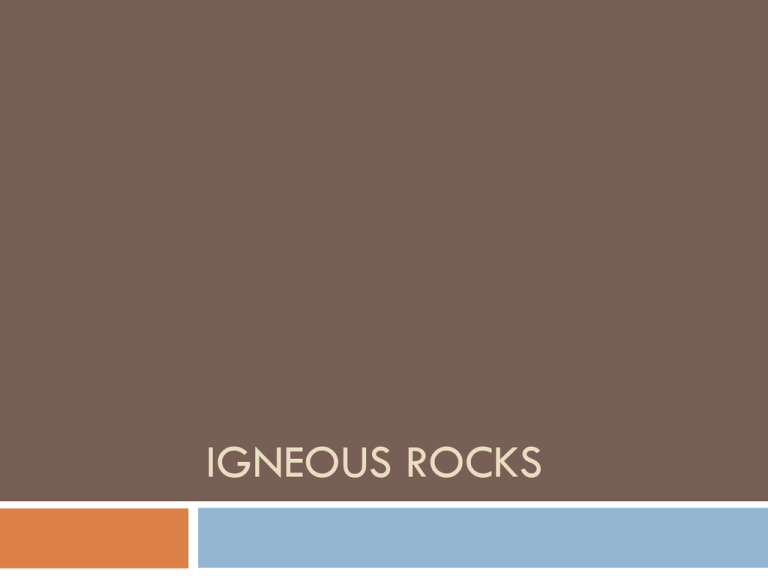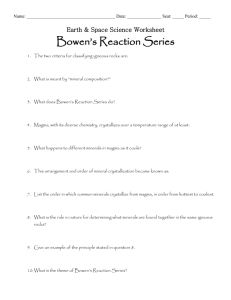Rocks - Quia
advertisement

IGNEOUS ROCKS Igneous Rocks Form from the crystallization of magma From Latin “ignis” which means fire Most common rocks in the Earths crust by far Two types of Igneous Rock Extrusive Cools quickly on the Earth’s surface Fine-grained Evidence We can actually watch extrusive igneous rocks from as lava cools Intrusive Cools slowly beneath the surface of the Earth Coarse-grained (large/rough) Evidence Cross-cutting relationship with other rock formations Cross-cutting Most igneous intrusive rocks have cross-cut something Magma comes up through cracks in rocks Magma the cools leaving an igneous intrusion Granite is the most common intrusive igneous rock Magma Not a pure substance Usually contains Molten rock Gases Mineral crystals Contains the same elements found in the Earth’s crust Most abundant compound is Silica (SiO4) Found in almost all rocks Melting Not all parts of magma melt at the same time This concept is called partial melting Crystallization Not all parts of magma crystallize (harden) at the same time This concept is called fractional crystallization Harder substances (diamonds) harden at the same time and are harder to melt Pressure causes substances to have different melting points Bowen’s Reaction Series Shows the relationship between cooling magma and mineral formation Mineral composition Again silica is the primary component of magma Felsic rocks contain high levels of silica Resistant to flow Granite, Obsidian Mafic rocks contain low levels of silica “watery stew” Gabbro, Basalt Uses Interlocking grain textures make them very strong They are also highly resistant to weathering These characteristics make Igneous rocks excellent building materials. SEDIMENTARY ROCKS Sedimentary Rocks Composed of small pieces of rocks that have been broken down and deposited Wind, water, and other forces transport sediments to sedimentary basins which can be more than 8 km thick. Clastic sediments Boulder Cobble Pebble Sand Silt Clay > 256 mm 256 - 64 mm 64 - 2 mm 2 – 0.062 mm 0.062 – 0.0039 mm < 0.0039 mm Buried Sediments experience high pressure and temperature This causes lithification, which is the process of sediments turning into rock Sedimentary rocks can also form from cementation Sediments are cemented together by mineral growth Sedimentary Uses Evidence of past events and life Due to the presence of fossils Energy sources Oil Natural Coal gas METAMORPHIC ROCKS Metamorphic Rocks From the Greek “meta” meaning change, and “morphe” meaning form Rock is buried and experiences great pressure and temperature, but doesn’t quite melt Very common in “mountain-building” areas During metamorphism, rocks change form while remaining solid Types of metamorphic rock Foliated Minerals with flat needle-like structures line up in wavy layers and bands Non-foliated Mineral grains lack the flattened structure Rock Cycle The remaking of rocks







